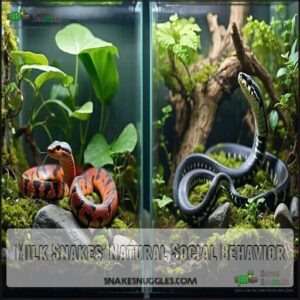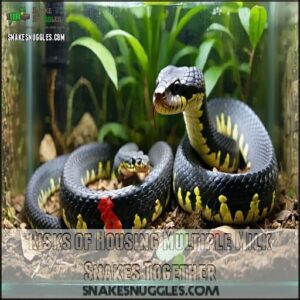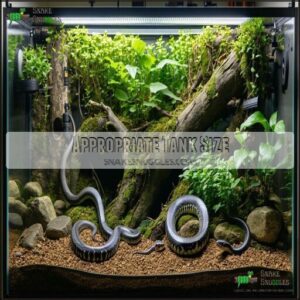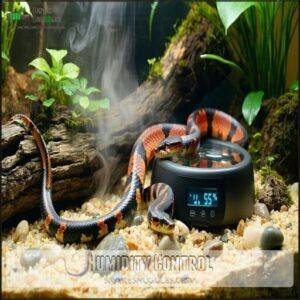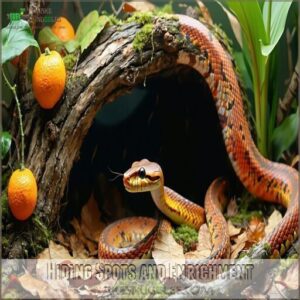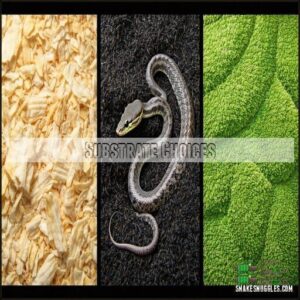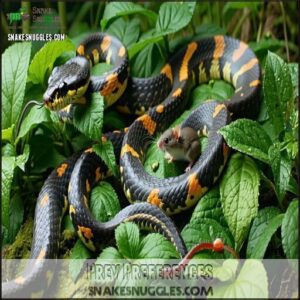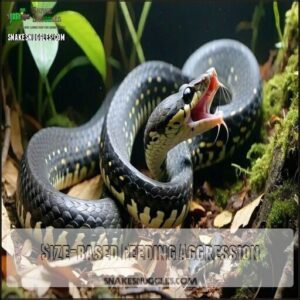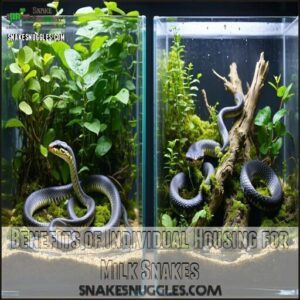This site is supported by our readers. We may earn a commission, at no cost to you, if you purchase through links.

In the wild, they avoid each other unless it’s mating season. Sharing an enclosure can lead to serious issues like stress, territorial disputes, or even cannibalism—yes, they may mistake a tankmate for food!
Housing multiple snakes also increases the risk of disease transmission and makes it harder to monitor their health or feeding. While there are rare exceptions, such as temporary housing for breeding, keeping them separate is the safest bet.
A peaceful, well-designed space for each snake guarantees their health and happiness—because who likes a grumpy reptile?
Table Of Contents
- Key Takeaways
- Milk Snakes’ Natural Social Behavior
- Risks of Housing Multiple Milk Snakes Together
- Enclosure Requirements for Single Milk Snake Housing
- Feeding Habits and Cannibalistic Tendencies
- Exceptions to Solitary Housing Rule
- Benefits of Individual Housing for Milk Snakes
- Alternative Social Enrichment for Milk Snakes
- Frequently Asked Questions (FAQs)
- Should milk snakes be housed together?
- Can milk snakes eat each other?
- Do milk snakes need a big enclosure?
- Can snakes live together?
- Can You house two snakes together?
- How do you handle a milk snake?
- Can you house two milk snakes together?
- Do milk snakes eat other milk snakes?
- Are milk snakes communal?
- Are milk snakes good to have around the house?
- Conclusion
Key Takeaways
- Milk snakes are solitary animals and shouldn’t be housed together; they may experience stress, aggression, or even cannibalism.
- Separate enclosures reduce risks like disease transmission and make monitoring each snake’s health much easier.
- Sharing a tank often leads to territorial disputes and feeding accidents, increasing the chances of harm.
- Individual housing allows you to customize the environment for each snake, ensuring proper care and enrichment.
Milk Snakes’ Natural Social Behavior
Milk snakes are naturally solitary animals, spending their lives avoiding unnecessary interactions with others of their kind.
They prefer to hunt, establish territory, and thrive independently, only seeking company during the brief mating season.
Solitary Nature in The Wild
Milk snakes are naturally solitary creatures, thriving through isolation in the wild—a behavior rooted in millions of years of evolution.
Thriving through isolation, milk snakes embody the wild’s golden rule: survival through solitude, honed by millions of years of evolution.
They avoid others to minimize interaction and reduce resource competition. Encounters with other snakes happen only during brief mating periods.
Their snake solitary nature is vital for survival.
- Fun fact: They mark territories using scent glands, creating invisible boundaries and avoiding conflicts.
Understanding the milk snake solitary lifestyle promotes proper care, supporting their happiness and health in captivity.
Territorial Instincts
Territorial instincts rule milk snake behavior.
They don’t play well with others—they fiercely guard their space through scent marking and resource defense.
When another snake intrudes, milk snake aggression ramps up, often leading to snake fights or dominance displays.
Forced cohabitation triggers relentless stress as their spatial needs clash.
Snake competition in shared enclosures causes bullying, stress, and sometimes injuries.
Their solitary evolution demands independence, making territorial behavior a survival tool, not a quirk.
Separate housing isn’t optional; it’s vital to prevent snake aggression and guarantee health and peace.
Seasonal Mating Behaviors
During the mating season, everything changes for normally introverted milk snakes.
Males become surprisingly bold as they follow pheromone trails left by females, driven by the primal urge to reproduce.
This temporary behavioral shift is fascinating but short-lived.
Male snakes even wrestle rivals to establish dominance—a rare interaction for such solitary creatures.
The unique courtship rituals of milk snakes include:
- Males tracking females through chemical trails.
- Persistent tongue flicking and body nudging as part of courtship.
- Gradual physical contact that leads to successful copulation.
- Immediate separation after mating with no long-term bond.
Factors like brumation effects help synchronize snakes’ breeding readiness, maximizing clutch size and genetic diversity.
However, once mating concludes, it’s back to business as usual—solitude reigns supreme.
This behavior highlights why housing milk snakes together outside breeding seasons risks both stress and even hatchling survival.
Lack of Social Bonding
When mating season ends, milk snakes return to a life ruled by instinctual isolation. These solitary creatures don’t crave connection—they’re wired to thrive alone.
Unlike social reptiles, they avoid interaction unless absolutely necessary, such as for mating or survival.
Snake cohabitation risks, like snake aggression or snake stress, stem from their solitary evolution, making them happiest in independent environments.
Housing two together increases stress, disrupts minimal interaction norms, and could trigger snake aggression. Respect their nature for true stress reduction.
Risks of Housing Multiple Milk Snakes Together
Housing multiple milk snakes together can lead to serious problems, like increased stress, aggression, and even cannibalism.
Their solitary nature makes shared enclosures a recipe for conflict and health issues, so it’s best to keep them separate for everyone’s safety.
Cannibalism Concerns
Cannibalism is a real danger when housing milk snakes together.
Their instincts as opportunistic feeders can trigger Ophiophagy Risk, especially with Juvenile Vulnerability and Size Disparity. Feeding Accidents are common, often leading to snake cannibalism if tails or prey are mistaken during meals.
One must also consider stressful environments, which can exacerbate these issues.
To prevent these snake cohabitation risks, follow this critical step:
- Individual Housing: Always separate milk snakes into their habitats.
This minimizes milk snake aggression, reduces feeding mishaps, and guarantees safety. Prevention Strategies like this are essential to avoid unnecessary injuries or fatalities.
Stress and Anxiety
Sharing space isn’t natural for milk snakes—they prefer the peace of solitude. Housing them together often triggers chronic stress, leading to immune suppression, erratic behavior, and hiding excessively.
Housing milk snakes together disrupts their natural peace, causing chronic stress, weakened immunity, and erratic behavior—solitary living ensures their well-being.
Imagine your snake constantly competing for territory or hiding spots—it’s like living next door to a noisy neighbor, constantly on edge. Stress speeds up when routines get disturbed or resources are limited.
Snakes may even refuse food, increasing regurgitation risks and making health monitoring tough. Notice snake stress signs like rapid breathing or attempts to escape? These are cries for help.
Want to avoid milk snake aggression? Stick to individual enclosures with proper snake stress management. Solo housing means a simpler, happier life for your scales-on-legs roommate, ensuring a life free from chronic stress.
Potential for Aggressive Interactions
Milk snakes don’t do well with roommates, often showing aggressive behavior when housed together.
Common conflicts include:
- Territorial Disputes: Larger snakes dominate basking spots and hides.
- Milk Snake Fights: Dominant ones injure weaker tankmates.
- Feeding Frenzy Issues: Fights erupt during meals.
- Snake Cannibalism Risks: Bigger snakes may prey on smaller ones.
Snake competition risks make solitary housing the safest choice.
Disease Transmission
When snakes share close quarters, disease transmission becomes a ticking time bomb.
Snake diseases like bacterial infections, viral outbreaks, and fungal risks quickly escalate in shared enclosures. Parasite spread thrives with constant contact, and bacterial infections like mouth rot emerge from shared water bowls or leftover food. Viral transmission skyrockets without quarantine protocols, putting all tankmates at risk. Even fungal diseases flourish in humid, unclean environments.
Here’s how you can avoid these pitfalls:
| Disease | Cause | Fix | Result |
|---|---|---|---|
| Parasite spread | Close contact | Strict parasite checks | Healthier snakes |
| Bacterial infections | Shared food sources | Feed individually | Fewer health problems |
| Viral outbreaks | Poor quarantine | Isolate new arrivals | Safer environment |
| Fungal risks | Dirty enclosures | Regular deep cleaning | Disease-free habitat |
Stick to individual tanks and stay vigilant!
Enclosure Requirements for Single Milk Snake Housing
Creating the perfect home for your milk snake is essential to keeping it healthy and happy.
A secure tank with the right size, temperature gradient, humidity, and hiding spots guarantees your snake feels safe and thrives in its environment, which is crucial for its overall well-being, particularly in terms of health.
Appropriate Tank Size
Space matters when creating the perfect milk snake housing. A minimum enclosure size of 48”L x 24”W x 24”H is essential for their comfort and natural behaviors.
A tank this size accommodates stretching, slithering, and even burrowing.
For a long-term setup, focus on sturdy, escape-proof materials and ample vertical space for climbing. Milk snakes are notorious escape artists, so you’ll want a secure lid!
Here’s what supports your snake enclosure size guide:
- Substrate depth: Promotes burrowing and keeps cleaning manageable.
- Ventilation: Maintains airflow and controls odors effectively.
- Growth potential: Allows room for your snake to thrive over time.
Proper enclosure size promotes your milk snake’s health and happiness. It’s also important to take into account temperature gradient options for their well-being.
Temperature Gradient Setup
To keep your milk snake happy and healthy, set up a proper temperature gradient. Every snake has heat needs, so balance your enclosure with a basking spot at 85-90°F and a cool side around 75-80°F.
This range helps them regulate their body temperature efficiently, much like how we adjust blankets at night.
Use heat sources like ceramic heat emitters or under-tank pads, paired with thermostats to avoid overheating. Consider a reptile heat regulator to maintain consistent temperatures.
Monitor the gradient using reliable thermometers or an infrared temp gun. Overhead heat lamps are great for basking, but airflow is equally important.
Proper ventilation prevents heat buildup, keeping the temperature gradient well-maintained. A cozy snake is a healthy snake—don’t skip proper temperature gradient maintenance!
Humidity Control
Maintaining proper humidity levels is essential for your snake’s health, influencing their skin and breathing. Aim for 40-60% humidity to meet snake humidity needs.
Improper humidity management can lead to shedding problems or respiratory infections. Accurate humidity control is easier with a good hygrometer. A reliable snake hygrometer is essential for monitoring humidity.
Follow these methods:
- Place a water bowl near a heat source to boost substrate moisture.
- Use well-ventilated enclosures to balance airflow and humidity levels.
- Always check hygrometer accuracy to monitor snake humidity management.
Avoid excess moisture—it could invite mold and compromise your snake’s habitat. Proper care includes understanding the importance of humidity control and using the right tools, like a reliable hygrometer, to ensure a healthy environment for your snake.
Hiding Spots and Enrichment
Creating the perfect snake enclosure setup means focusing on what milk snakes love: hiding spots and enrichment.
These natural explorers need at least two secure hiding spots—one on the warm side for basking and another on the cool side to regulate their temperature.
For enrichment, mix in climbing opportunities like cork bark, driftwood, or hollow logs.
Include small environmental elements such as smooth stones or textured bark to stimulate their senses.
Burrowing needs can be met with sturdy décor like half-buried hides or shallow tunnels.
A naturalistic design featuring artificial plants or rocks can help break sightlines, reducing stress.
Thoughtful milk snake housing with engaging hiding spots encourages healthy activity and makes for a relaxed, happier snake.
This setup should include a mix of elements that provide both physical and sensory enrichment, as well as opportunities for climbing and burrowing.
Substrate Choices
In the context of snake substrate, nothing beats options that are safe, practical, and easy to maintain.
The right substrate helps control humidity, supports burrowing instincts, and mimics natural environments.
Here are some great substrate choices for milk snake housing:
- Aspen Shavings: Ideal for dry habitats but keep them mold-free by avoiding moisture.
- Coconut Fiber: A perfect choice for humid enclosures, plus it’s eco-friendly and encourages burrowing.
- Reptile Carpet: Easy to clean and reusable, though it doesn’t allow digging.
For aspen shavings, consider safe bedding options for your snake.
Avoid cedar at all costs—it’s toxic to snakes!
Paper towels also work great for simple setups or quarantine.
Find the balance between function and your snake’s comfort for a perfect snake enclosure.
Feeding Habits and Cannibalistic Tendencies
You need to be cautious when feeding milk snakes, especially if they’re housed together, as their natural instincts can lead to unexpected problems.
Mistaken identity, size-based aggression, or even hunger can trigger their cannibalistic tendencies, putting both snakes at risk, due to their natural behavior when housed in the same environment, which may lead to unexpected problems.
Prey Preferences
Milk snakes thrive on a steady diet of frozen-thawed rodents, like mice or small rats, sized to match their body’s width.
Choosing the right rodent size prevents choking hazards and allows them to digest properly.
Skip live prey—it’s not worth the bites or stress.
Stick with a consistent feeding frequency, usually every 5-7 days, to meet their nutritional needs and avoid hunger-driven issues like snake cannibalism.
Offering some prey variety may mimic wild habits, but safety comes first in any snake feeding setup.
Size-based Feeding Aggression
Size-based feeding aggression in milk snakes is a recipe for disaster, especially when smaller snakes are involved. Larger snakes naturally dominate meals, creating unsafe conditions for their tankmates.
This can escalate into snake cannibalism, with bigger snakes mistaking smaller companions for prey. Sharing space amplifies competition risks, leading to starvation and injury for the weaker ones.
Aggression peaks during feeding time, when dominance displays ramp up. Injuries are common, and competition risk for food increases substantially. Even with proper feeding frequency, separation is safer.
- **Smaller snakes face constant injury potential.
- **Dominance displays cause chaos and stress.
- **Prey size confusion triggers attacks.
- **Snake feeding habits foster competition.
- **Combined, these lead to dangerous snake cannibalism.
Mistaken Identity During Feeding
Feeding multiple milk snakes together isn’t just risky; it’s asking for trouble.
These snakes are fueled by instinct, and factors like Scent Confusion and sudden movement can easily trigger attacks. A snake’s vision struggles in low-light conditions, so they may strike before realizing it’s not prey but a tankmate.
This is especially dangerous with Size Discrepancies—a smaller snake can quickly become a meal. Even well-fed snakes might get caught up in a feeding response if a companion moves like prey.
Their snake mistaken identity tendencies, combined with snake competition for food, often lead to surprising aggression.
To avoid tragic outcomes, Feeding Isolation is your safest bet. Use separate containers during meals and keep snakes apart.
This simple step prevents snake cannibalism while reducing stress and injuries. Prioritizing Prevention Methods protects their health and respects their natural instinct to live alone.
Hunger-induced Cannibalism
Skipping meals or using prey that’s too large can lead to hunger-induced cannibalism in milk snakes, a dangerous snake feeding issue. Proper care helps avoid this.
To prevent snake cannibalism, follow these steps:
- Stick to consistent feeding schedules—inconsistent feeding causes hunger stress, increasing aggression.
- Choose prey matching your snake’s size needs—wrong prey size sparks feeding chaos.
- Always feed snakes separately—same-enclosure feeding risks mistaken identity during low light levels.
Separate feeding in individual tanks guarantees stress-free meals, preventing predation and keeping hunger-induced cannibalism at bay.
Exceptions to Solitary Housing Rule
While milk snakes are happiest alone, there are a few rare exceptions to this rule.
These situations—such as controlled breeding, brief emergencies, or professional research—require careful planning to guarantee the snakes remain safe and stress-free.
Temporary Breeding Arrangements
When planning breeding arrangements, timing and setup are key.
Pair compatible milk snakes only when they’ve reached sexual maturity, using a neutral enclosure with temperatures between 78-88°F to mimic natural conditions.
Supervise mating closely and look for signs like the female’s cloacal gaping, which indicates readiness.
Always separate post-mating to avoid aggression or cannibalism.
Prepare for egg incubation and hatchling care in advance, as successful snake breeding requires attention to detail.
Temporary cohabitation works only with careful monitoring to guarantee safety and minimize stress for both snakes.
Very Short-term Emergency Situations
Natural disasters, enclosure failures, or medical isolation may lead to emergency situations requiring temporary relocation for your milk snakes.
While it’s risky, short-term cohabitation can work if managed well.
Here’s how to guarantee snake safety during emergencies:
- Provide dividers: Use partitioned containers or barriers to guarantee quick separation and avoid direct contact.
- Watch closely: Check regularly for stress, injury, or aggression, as snake cannibalism is still possible.
- Replicate conditions: Maintain correct temperatures and humidity to reduce discomfort.
- Keep it brief: Limit shared housing to 48–72 hours to minimize harm.
Safety first, always prioritize separation when conditions improve.
Professional Herpetological Research Settings
In herpetological research, housing milk snakes together serves scientific goals like snake social behavior research, genetic studies, and venom research.
Strict research ethics guarantee their safety, with controlled conditions for data collection and snake housing studies. These projects often support conservation efforts or explore snake species compatibility research, advancing our understanding of reptile dynamics.
However, such controlled experiments aren’t practical or safe at home. Unlike labs, pet enclosures can’t mimic these regulated conditions, making snake cohabitation experiments unsuitable for hobbyists.
Milk snakes thrive best when they live solo. A suitable vivarium should have good ventilation essential for proper airflow.
Benefits of Individual Housing for Milk Snakes
Housing your milk snake alone reduces stress and guarantees a healthier, more peaceful environment. It also makes monitoring their health and tailoring their care to their unique needs much easier.
Reduced Stress Levels
Giving your milk snake its own space isn’t just a kindness—it’s how they thrive naturally.
These solitary creatures prefer minimal interaction, and cohabitation disrupts their instinctual comfort zone. Sharing an enclosure may look convenient, but it sparks constant tension over heat sources, hiding spots, and territory, which can lead to snake stress.
By housing them individually, you’re guaranteeing a peaceful, natural isolation where they can flourish without interruptions. You’ll notice improved behavior and overall health.
Here’s what they gain in their private habitat:
- No competition for hiding spots, warmth, or territory.
- A calm, pressure-free environment supporting independent thriving.
- Fewer snake stress signs caused by aggressive encounters.
- Freedom to stay active on their own terms.
- The ultimate snake stress management solution for their well-being.
Easier Health Monitoring
Keeping milk snakes alone makes snake health monitoring far more effective. You’ll notice skipped meals, shedding problems, or snake stress signs faster.
Individual observation helps spot snake disease symptoms like weight loss or unusual activity, allowing quicker diagnosis and targeted treatment.
Separate enclosures also reduce disease spread, like snake parasite symptoms, and facilitate accurate records for veterinary care.
Maintaining proper ventilation is also vital for their well-being. By prioritizing stress reduction and focusing on individual needs, you’ll greatly enhance your snake’s overall well-being.
Customized Care and Environment
When you house a milk snake alone, it’s easy to fine-tune your snake enclosure specifically for its needs.
Without cohabitation stress, you can focus on creating a perfect environment.
Snake enclosure customization lets you:
- Optimize temperature control with precise basking and cool zones.
- Adjust humidity levels to support healthy shedding and hydration.
- Choose ideal substrate options, like aspen or coconut fiber, for burrowing and cleaning ease.
- Add hiding spots and enrichments, such as branches or décor, for natural behaviors.
This customized care promotes health and stress-free living!
Prevention of Accidental Breeding
Unexpected breeding can catch you off guard, making individual enclosures a smart choice. Housing milk snakes separately keeps you in control of sex-specific behaviors like male aggression during mating season and protects females from unwanted pregnancies.
Even a divided tank isn’t foolproof—snakes are escape artists, after all! Accidental breeding introduces resource strain, space issues, and potential health risks for the snakes.
With proper separation strategies, you’re free to manage breeding intentionally and avoid surprises like unexpected hatchlings or overcrowding. Here’s how snake isolation helps:
- Stops accidental hatchlings from appearing.
- Reduces stress caused by unplanned breeding.
- Keeps males calm and less aggressive.
- Protects females from unnecessary pregnancies.
- Lets you use sexing milk snakes and incubation management safely.
Stable enclosures = happy snakes, and happy snakes mean fewer headaches for you, ensuring happy snakes and fewer headaches with proper separation and intentional breeding management, which leads to less aggressive behavior.
Alternative Social Enrichment for Milk Snakes
You don’t need to keep milk snakes together to enrich their lives.
Instead, focus on safe handling, stimulating environments, and activities that mimic their natural behaviors without the risks of cohabitation.
Safe Handling Practices
Handling milk snakes safely means staying calm and attentive. Always support your snake fully, like cradling a delicate rope—avoid letting any part dangle.
Clean hands or handling gloves reduce risks; good hygiene protocols are essential. Use a snake hook if you’re nervous or if the snake seems agitated. Gentle, steady movements minimize stress and bite prevention is easier when you recognize cues, like tail rattling or defensive posturing.
For enhanced safety, consider puncture-resistant gloves to protect your hands. Supervise kids during handling sessions to teach safe restraint. Respect your snake’s behavior—it guarantees stress-free care for both you and your slithery companion.
Environmental Stimulation
Enhancing your milk snake’s well-being starts with thoughtful environmental stimulation. By creating a naturalistic design, you can keep your snake both engaged and relaxed.
A varied habitat promotes natural behaviors and reduces stress.
Here are a few ideas for snake enclosure enrichment:
- Add climbing structures, such as sturdy branches, to mimic their wild environment and encourage physical activity.
- Incorporate Habitat Variety, including mixed substrates like moss or shredded wood, for sensory enrichment and exploration.
- Introduce visual barriers, such as artificial plants or rocks, to create Enclosure Complexity and secure zones.
A well-planned snake enclosure design with these features offers cognitive challenges and promotes a thriving, happy snake.
Scent-based Enrichment Activities
Milk snakes rely heavily on their sense of smell to navigate their environment.
You can tap into this natural behavior with scent-based enrichment activities that mimic their instincts.
- Enrichment Rotation: Introduce unique smells to their enclosure weekly. For example, sprinkle prey-scented bedding or place sanitized leaves and natural scents like shed snake skins in hidden spots.
Rotate these scents to keep their interest alive and prevent boredom.
For a fun twist, create “scent trails” using natural scents, leading to their favorite hiding places. Small, clean bottles filled with mild fragrances like tea leaves or lemon can also spark curiosity.
Always clean and sanitize objects before introducing them.
These snake enrichment ideas encourage scent tracking, keep them mentally stimulated, and promote exploration in their habitat while respecting their solitary nature. It’s like a scavenger hunt for snakes!
Visual Interaction Through Separate Enclosures
A clever enclosure setup can help milk snakes enjoy visual stimulation without risky cohabitation.
Placing tanks side-by-side allows for safe visual interaction, encouraging their natural curiosity. You’ll notice behavioral changes like increased movement or exploration, but don’t worry—this is normal.
If a snake seems stressed, enclosure barriers, like draped fabric, can block light exposure and give privacy. Glass clarity guarantees they can see but still feel secure.
This arrangement supports snake compatibility while avoiding cannibalism, aggression, or other risks, giving each milk snake plenty of space to thrive individually. It’s a win-win!
Frequently Asked Questions (FAQs)
Should milk snakes be housed together?
Imagine thinking two milk snakes could coexist peacefully—it’s a recipe for stress and disaster.
These solitary reptiles prefer their own space, avoiding others entirely.
Housing them together risks aggression, cannibalism, and health issues.
Keep them separate.
Can milk snakes eat each other?
Yes, milk snakes can eat each other.
Their ophiophagous nature means they see other snakes, including milk snakes, as potential prey.
Size differences, hunger, or stress can trigger cannibalism, making solitary housing the safest option.
Do milk snakes need a big enclosure?
Your milk snake doesn’t need a mansion, but it does need space.
A 20-gallon tank works for adults.
Add hiding spots, a secure lid, and temperature gradients for comfort—think cozy, not cramped!
Can snakes live together?
Two heads aren’t always better than one in the case of snakes.
Most snakes, especially milk snakes, prefer solitude.
Housing them together can cause stress, aggression, or cannibalism.
Keep them separate for their well-being.
Can You house two snakes together?
Housing two snakes together can be risky.
They often compete for resources, experience stress, and may even harm each other.
Most species, especially solitary ones, thrive better alone in their own secure, well-designed enclosures, which helps prevent them from experiencing undue stress.
How do you handle a milk snake?
Holding a milk snake is like cradling a flowing ribbon of life.
Approach slowly, use both hands for support, avoid its head, and maintain calm movements.
Never squeeze; the snake’s comfort guarantees your bond.
Can you house two milk snakes together?
You shouldn’t house them together—milk snakes are solitary by nature.
They may see each other as prey, leading to stress or even cannibalism.
Separate enclosures guarantee their safety, health, and peace of mind.
Do milk snakes eat other milk snakes?
Did you know milk snakes are ophiophagous, meaning they may eat other snakes, including their own kind?
It’s a survival instinct, especially when food is scarce or during mistaken identity while hunting.
Are milk snakes communal?
Milk snakes aren’t communal creatures.
They prefer solitary lives, avoiding others except during mating or brumation.
Keeping them together often creates stress, aggression, and even cannibalism.
For everyone’s safety, one snake per enclosure works best.
Are milk snakes good to have around the house?
A milk snake in your house is like having a quiet, quirky roommate—they’re harmless, control pests like rodents, and don’t require much attention.
Just guarantee secure housing and proper care to keep them thriving.
Conclusion
While it may sound cozy to house milk snakes together, these independent reptiles thrive best in solitary spaces.
Their solitary nature, coupled with risks like cannibalism, stress, and disease, makes shared enclosures unsuitable.
To guarantee your snake’s health and well-being, stick to individual housing with proper care and enrichment.
Remember, milk snakes don’t crave companionship, so prioritize customized setups that mimic their natural environment.
After all, a peaceful snake is a happy snake—no roommates required, and this setup ensures they live in a happy environment.

